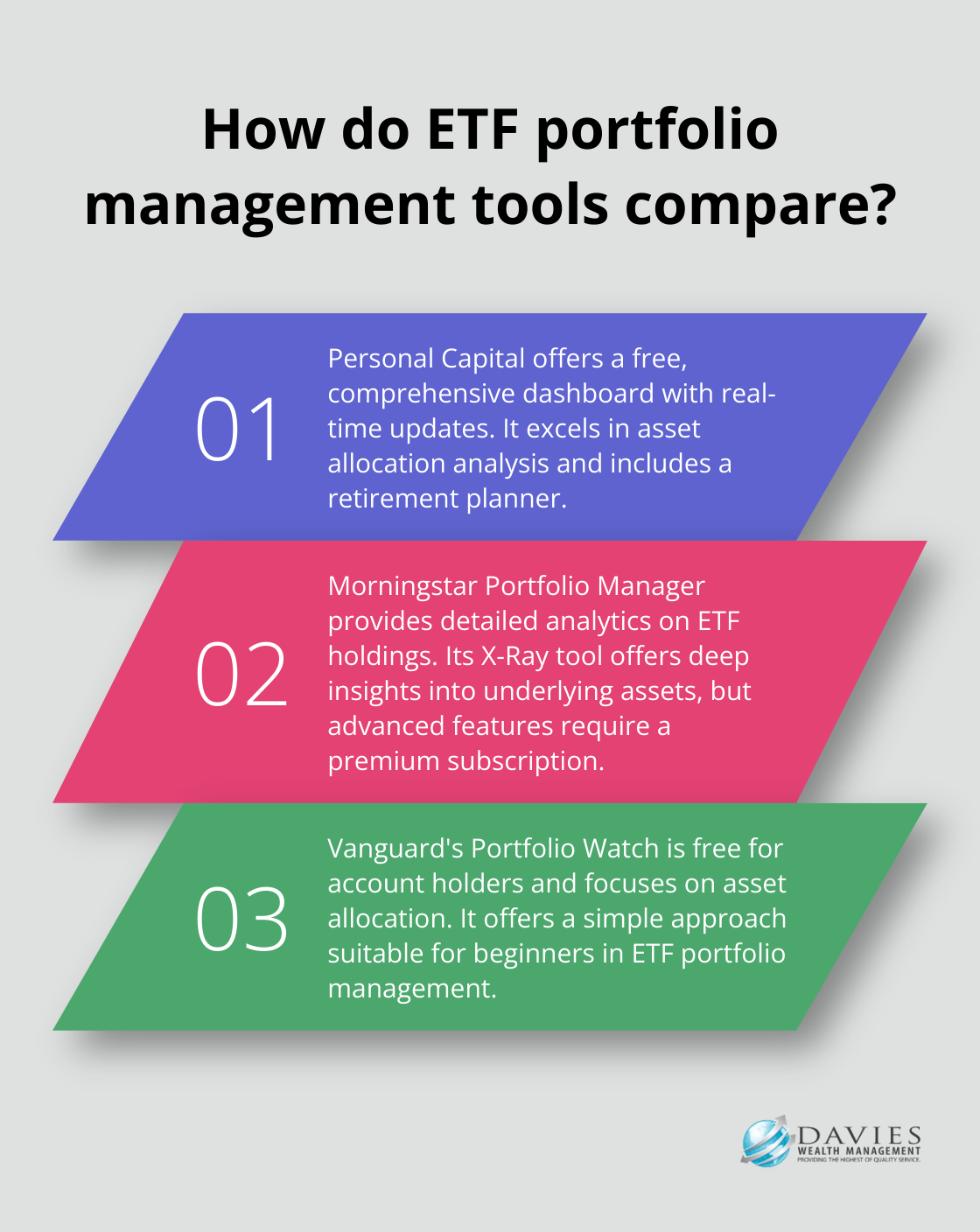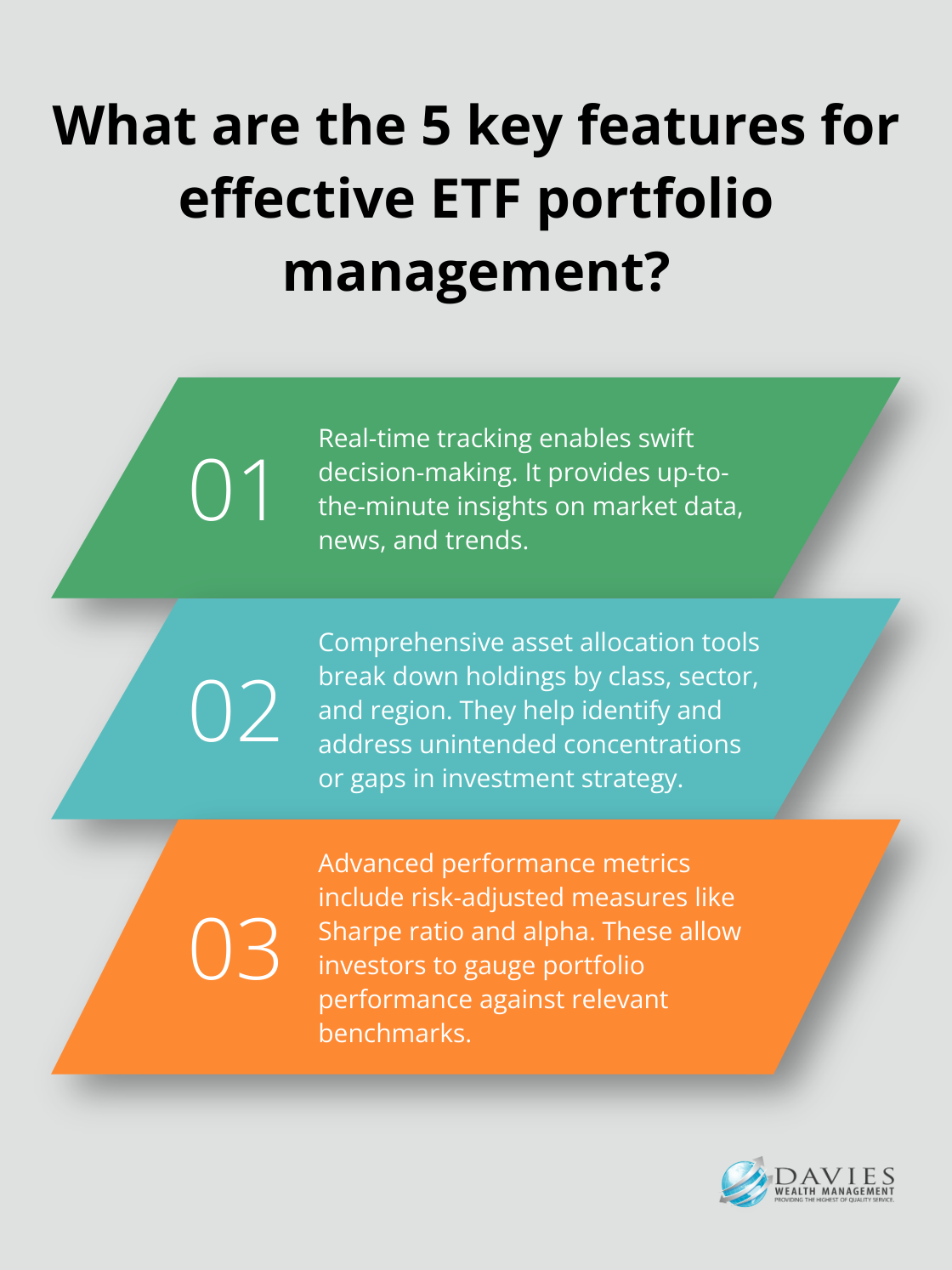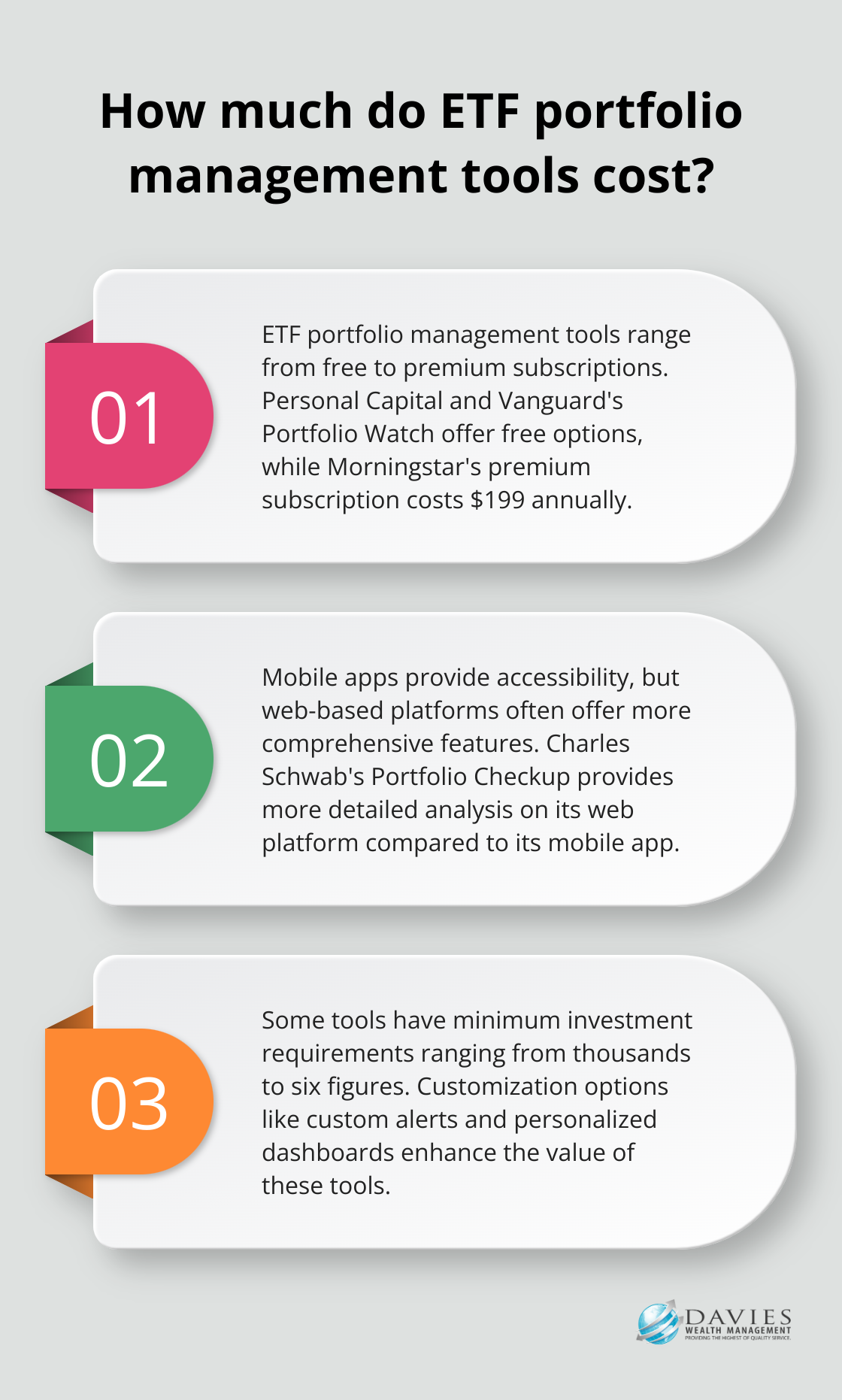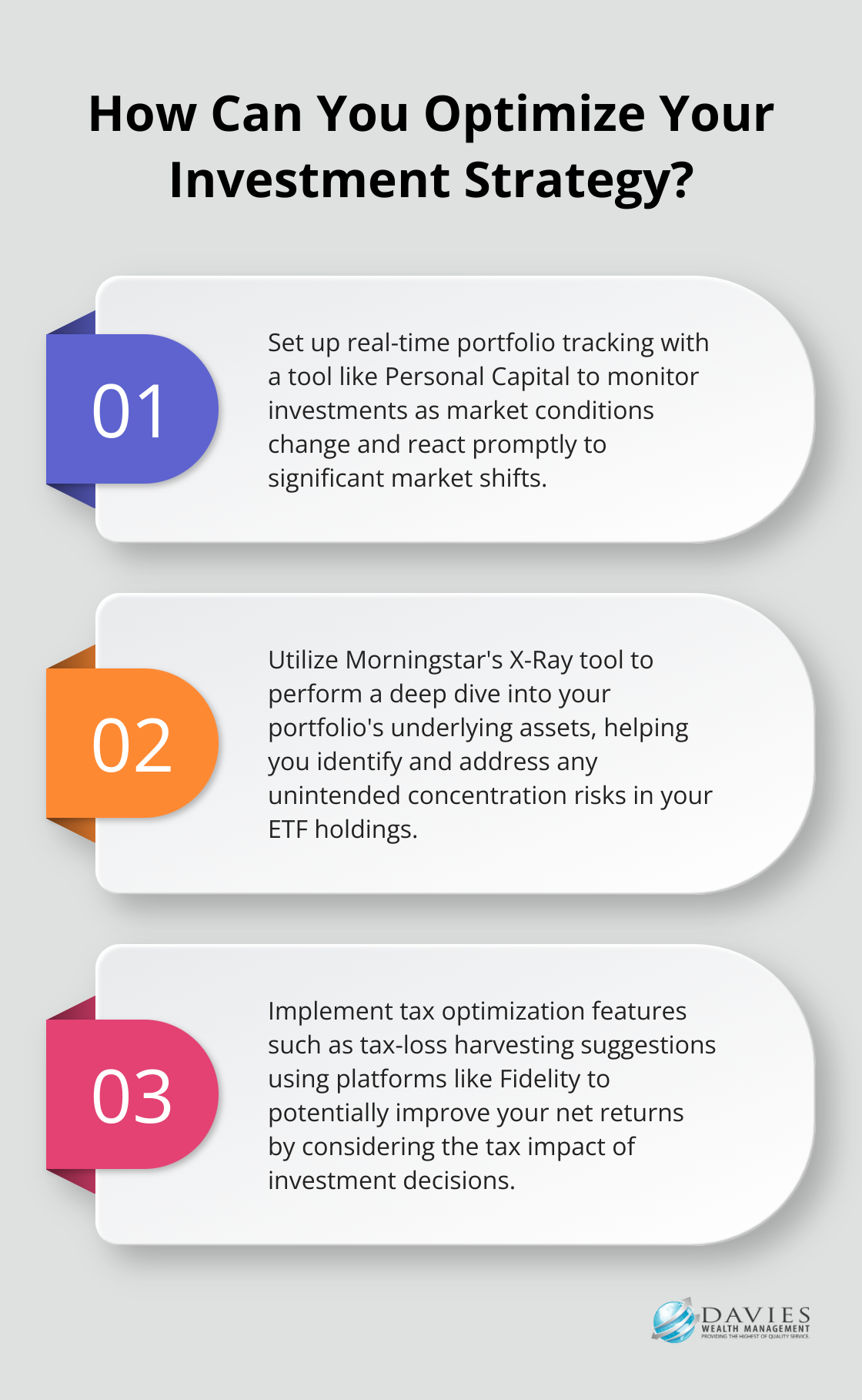At Davies Wealth Management, we understand the importance of effective ETF portfolio management. While many investors grasp the difference between portfolio management and investment management, choosing the right tools can be challenging.
In this post, we’ll explore top ETF portfolio management tools and their key features, helping you make informed decisions for your investment strategy.
Top ETF Portfolio Management Tools Compared
At Davies Wealth Management, we’ve analyzed various ETF portfolio management tools to help you make an informed decision. Here’s our breakdown of four popular options:
Personal Capital
Personal Capital offers a comprehensive financial dashboard that includes robust portfolio management features. It’s free to use and provides real-time updates on your investments. The tool excels in asset allocation analysis, offering insights into your portfolio’s diversification across different sectors and asset classes. Personal Capital also provides a retirement planner and investment checkup feature (which can be particularly useful for long-term ETF investors).
Morningstar Portfolio Manager
Morningstar, a well-known name in investment research, doesn’t disappoint with their Portfolio Manager. It offers detailed analytics on your ETF holdings, including performance metrics, risk assessments, and fees analysis. One standout feature is the X-Ray tool, which provides a deep dive into your portfolio’s underlying assets, helping you avoid unintended concentration risks. However, some of the more advanced features require a premium subscription.
Vanguard’s Portfolio Watch
Vanguard’s Portfolio Watch is a free tool available to Vanguard account holders. It provides a straightforward approach to portfolio analysis, focusing on asset allocation and risk assessment. While it may not offer the depth of analysis found in some other tools, its simplicity makes it an excellent option for beginners or those who prefer a no-frills approach to ETF portfolio management.
Charles Schwab’s Portfolio Checkup
Charles Schwab’s Portfolio Checkup tool stands out for its user-friendly interface and comprehensive analysis. It offers features like asset allocation review, goal planning, and performance analysis. The tool also provides personalized recommendations based on your investment goals and risk tolerance. While it’s free, it’s only available to Schwab account holders.
Davies Wealth Management’s Customized Approach
While these tools offer valuable insights, Davies Wealth Management provides a more personalized approach to ETF portfolio management. We combine cutting-edge technology with expert human analysis to create tailored strategies that align with your specific financial goals and risk tolerance.

When selecting an ETF portfolio management tool, consider factors like the depth of analysis you need, the user interface, and whether you’re willing to pay for premium features. The best tool for you will depend on your specific investment goals and level of experience.
As we move forward, let’s explore the key features you should look for in ETF portfolio management tools to ensure you’re making the most informed decision for your investment strategy.
Essential Features for Effective ETF Portfolio Management
Real-Time Tracking and Analysis
Effective ETF portfolio management requires tools that provide up-to-the-minute insights. Real-time portfolio tracking allows investors to monitor their investments as market conditions change, enabling swift decision-making. These tools offer real-time access to market data, news, and trends to help investors make informed decisions. This immediacy proves particularly valuable during volatile market periods, allowing investors to react promptly to significant market shifts.
Comprehensive Asset Allocation Insights
A robust asset allocation analysis tool forms the backbone of maintaining a balanced portfolio. Investors should look for features that break down holdings by asset class, sector, and geographic region. Advanced tools (like those offered by industry leaders) provide a detailed view of a portfolio’s underlying assets. This granular insight helps identify and address any unintended concentrations or gaps in an investment strategy.
Advanced Performance Metrics
Top-tier ETF portfolio management tools offer in-depth performance reporting. These go beyond simple return calculations to include risk-adjusted metrics such as Sharpe ratio and alpha. The Sharpe ratio divides a portfolio’s excess returns by a measure of its volatility to assess risk-adjusted performance. Such advanced metrics allow investors to gauge their portfolio’s performance against relevant benchmarks, providing a more comprehensive view of investment success.
Tax Optimization Features
Tax implications play a significant role in overall investment returns. The best ETF portfolio management tools incorporate tax optimization features. These might include tax-loss harvesting suggestions, capital gains distribution forecasts, and after-tax return calculations. Tax-loss harvesting involves selling stocks, bonds, mutual funds, ETFs, or other investments you own in taxable accounts that have lost value since you bought them. By considering the tax impact of investment decisions, investors can potentially improve their net returns.
Rebalancing Recommendations
Automated rebalancing recommendations help maintain the desired asset allocation over time. As market movements cause portfolio weightings to drift, these tools suggest trades to bring the portfolio back in line with the target allocation. This feature saves time and helps investors stick to their long-term investment strategy, even in the face of short-term market fluctuations.

The features discussed above form the foundation of effective ETF portfolio management. However, the selection of the right tool depends on individual needs, investment experience, and portfolio complexity. As we move forward, we’ll explore how costs and accessibility factor into the decision-making process when choosing an ETF portfolio management tool.
Navigating Cost and Access in ETF Portfolio Management
The Price of Performance
ETF portfolio management tools come in various price ranges, from free options to premium subscriptions. Some tools offer a free version so you can test it out, along with the ability to sync all of your financial accounts. Personal Capital and Vanguard’s Portfolio Watch offer solid features at no cost. In contrast, Morningstar’s premium subscription (priced at $199 annually) unlocks advanced tools like the X-Ray feature. However, higher costs don’t always guarantee better results.
Mobile vs. Desktop: The Accessibility Factor
The rise of mobile investing has made app availability an important consideration. However, web-based platforms often provide more comprehensive features. Charles Schwab’s Portfolio Checkup, for example, offers a more detailed analysis on its web platform compared to its mobile app. Your choice should reflect how you prefer to interact with your investments.
Seamless Integration: A Time-Saver
Integration with brokerage accounts can streamline your ETF portfolio management process. Key features include the ability to sync data from financial accounts and measure performance against a benchmark index or fund. This integration can save time in manual data entry and reconciliation.
Minimum Investment Requirements
Some ETF portfolio management tools impose minimum investment requirements. These thresholds can range from a few thousand dollars to six-figure sums. It’s essential to consider these requirements when selecting a tool, as they may limit your options based on your current investment capacity.
Customization Options
The ability to tailor the tool to your specific needs can greatly enhance its value. Look for platforms that allow you to set custom alerts, create personalized dashboards, and generate reports that align with your investment strategy. This flexibility ensures that the tool serves your unique financial goals and preferences.

Final Thoughts
The ETF portfolio management tools we explored offer diverse features for investors. Each platform provides unique strengths, from comprehensive dashboards to detailed analytics. Selecting the right tool depends on your investment goals, experience, and management style.

Understanding the difference between portfolio management and investment management helps in choosing appropriate tools. Portfolio management takes a holistic approach, considering asset allocation and risk management. These tools cater to this broader perspective, offering real-time tracking and rebalancing recommendations.
At Davies Wealth Management, we combine technology with expert analysis for personalized strategies. Our team can help you navigate ETF investing and overall wealth management. For tailored investment advice that aligns with your goals, visit Davies Wealth Management to learn more about our services.



Leave a Reply